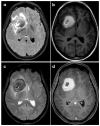The Hemorrhagic Side of Primary Angiitis of the Central Nervous System (PACNS)
- PMID: 38398061
- PMCID: PMC10886751
- DOI: 10.3390/biomedicines12020459
The Hemorrhagic Side of Primary Angiitis of the Central Nervous System (PACNS)
Abstract
Primary Angiitis of the Central Nervous System (PACNS) is a rare cerebrovascular disease involving the arteries of the leptomeninges, brain and spinal cord. Its diagnosis can be challenging, and the current diagnostic criteria show several limitations. Among the clinical and neuroimaging manifestations of PACNS, intracranial bleeding, particularly intracerebral hemorrhage (ICH), is poorly described in the available literature, and it is considered infrequent. This review aims to summarize the available data addressing this issue with a dedicated focus on the clinical, neuroradiological and neuropathological perspectives. Moreover, the limitations of the actual data and the unanswered questions about hemorrhagic PACNS are addressed from a double point of view (PACNS subtyping and ICH etiology). Fewer than 20% of patients diagnosed as PACNS had an ICH during the course of the disease, and in cases where ICH was reported, it usually did not occur at presentation. As trigger factors, both sympathomimetic drugs and illicit drugs have been proposed, under the hypothesis of an inflammatory response due to vasoconstriction in the distal cerebral arteries. Most neuroradiological descriptions documented a lobar location, and both the large-vessel PACNS (LV-PACNS) and small-vessel PACNS (SV-PACNS) subtypes might be the underlying associated phenotypes. Surprisingly, amyloid beta deposition was not associated with ICH when histopathology was available. Moreover, PACNS is not explicitly included in the etiological classification of spontaneous ICH. This issue has received little attention in the past, and it could be addressed in future prospective studies.
Keywords: ABRA; CAA; CAA-related inflammation; ICH; PACNS; SVD; intracranial hemorrhage; large vessels; medium vessels; small vessels; stroke.
Conflict of interest statement
The authors declare no conflicts of interest regarding the topic of this paper.
Figures



References
-
- Pascarella R., Antonenko K., Boulouis G., De Boysson H., Giannini C., Heldner M.R., Kargiotis O., Nguyen T.N., Rice C.M., Salvarani C., et al. European Stroke Organisation (ESO) guidelines on Primary Angiitis of the Central Nervous System (PACNS) Eur. Stroke J. 2023;8:842–879. doi: 10.1177/23969873231190431. - DOI - PMC - PubMed
Publication types
LinkOut - more resources
Full Text Sources
Research Materials
Miscellaneous

